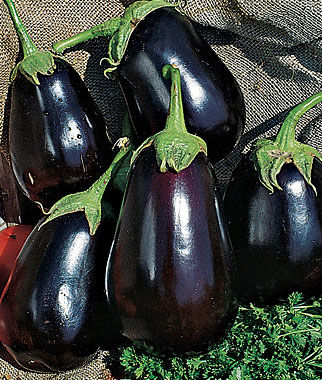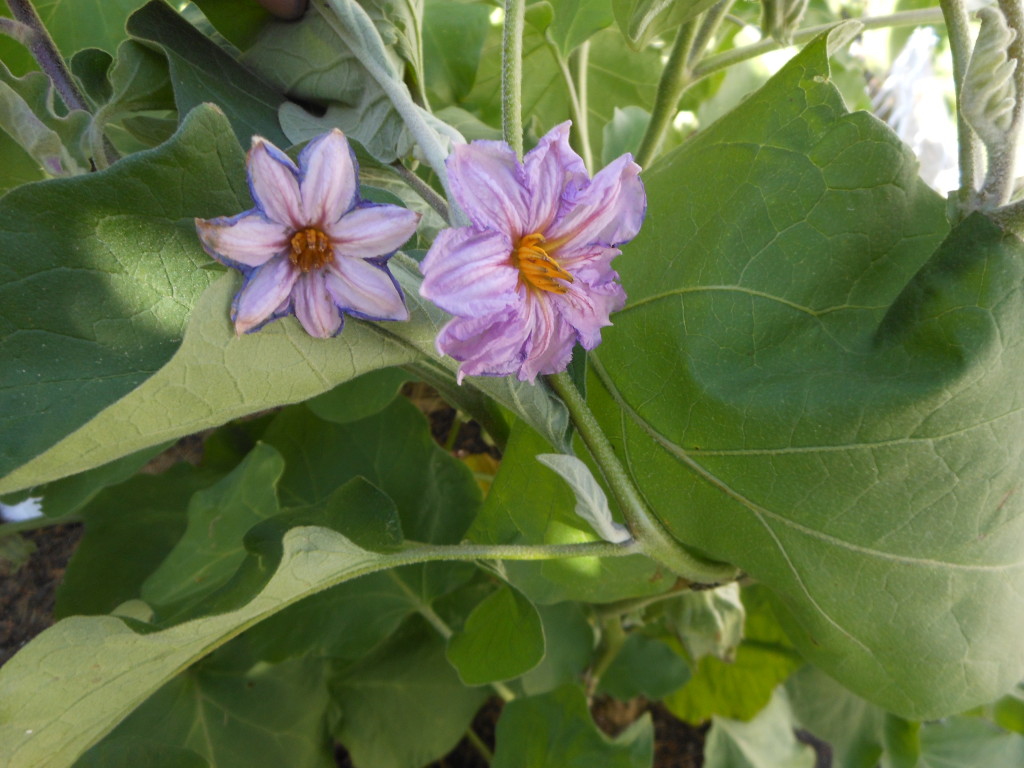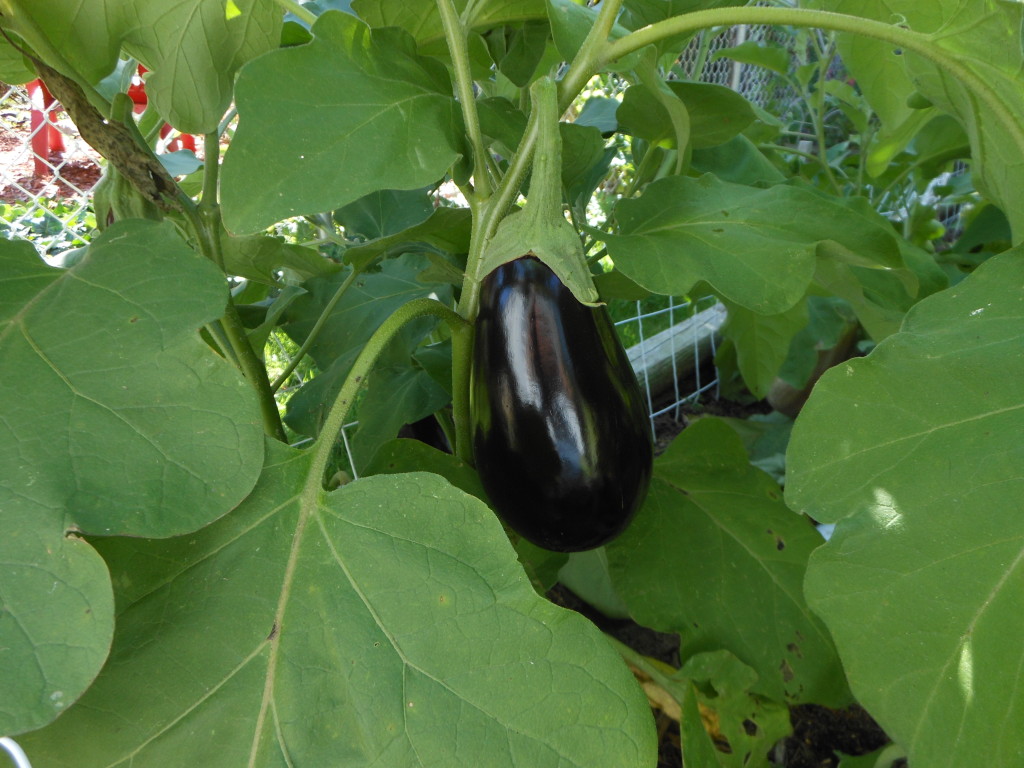Eggplant Gardening

Eggplant, Solanum melongena, is a perennial from the nightshade family, Solanaceae, and is cultivated in tropical and subtropical climates throughout the world. It comes from the same family as potatoes, tomatoes, and several other poisonous nightshades. Eggplant is native to Southeast Asia and a staple in Mediterranean cuisine since ancient times. It’s typically grown as an annual and can reach a height of 1.5 m, giving large, slightly lobed leaves and purple flowers. The fruit is a large, egg-shaped deep purple berry with smooth skin and several small seeds. Though the fruit, commonly consumed as a vegetable, is typically purple, you can also find it in other colors.
Types & Varieties of Eggplant
Other than the large, oblong, purple eggplants you find in grocery stores, there are several other varieties too. They come in unique shapes and colors. Besides the deep purple color that you’re familiar with, red, pink, yellowish, and white eggplants also exist.
Common Varieties of Eggplant:
Black Beauty – The variety matures in 72 to 85 days, producing large, oval fruits with purplish-black skin that hold color and texture well after being harvested. It’s an heirloom variety that grows up to 24 to 30 inches tall, bearing 4 to 6 fruits per plant.
Little Fingers – Maturing in as little as 68 days, this variety bears slim, 4 to 6 inches long fruits with glossy dark purple skin and a sweet, delicate flavor.
Easter Egg – Maturing in 52 to 65 days, it bears small, white fruits in the shape and size of an egg.
Hansel – Harvested in about 55 days, this cultivar produces long, thin purple fruits that appear in clusters on the branches. It’s best picked when the fruits are just about 3 inches long, though they can grow up to 10 inches long when fully mature.
For a self-sufficient garden, grow 1 to 2 eggplant plants per person, spacing them 24 to 30 inches apart in rows that are at least 3 feet apart.
Temperature and Timing for Growing Eggplant
Eggplant is a warm-weather crop and requires at least 5 months of warm temperatures for proper fruit development. The ideal temperatures to grow eggplant lie between 70 and 85°F. If the weather is cooler, the growth will slow down. They’re typically grown as a spring crop, so they can grow through the warm summers.
Sun Exposure and Soil Requirements
Eggplant grows best in full sun. Make sure they receive at least 6 hours of undisturbed sunlight each day. If you have a spot that receives more sunlight, that’s even better.
Sandy loam or loam soil is best for eggplant. Make sure it’s well-drained, rich in organic matter, and has a pH between 5.8 and 6.5 for optimal growth.
How to Plant Eggplant
Eggplant gardening starts with planting the seeds indoors 8 to 9 weeks before the last spring frost. Start the seeds in seedling trays or peat pots filled with a good seed starting mix. Set the seeds ¼ inch deep in the soil and spray the soil with water to moisten it. Place the pots over a heating mat, making sure the temperature is between 75 to 85°F for optimal germination.

Seedlings will sprout in a week or two. As soon as you see sprouting, place the pot at a window that receives plenty of sunlight. Thin the seedlings to 2 to 3 inches apart once they have at least two sets of leaves.
Wait until after the last frost of the spring to transplant the seedlings outdoors. Outdoor temperatures should be consistently above 50°F when you plan on transplanting the seedlings into the garden. Amend the garden soil with lots of organic matter before planting the seedlings.
Harden off the seedlings in about a week before you set them in the garden bed permanently. If you want to skip starting the seeds indoors, you can purchase 6 to 8-weeks old transplants from the nursery right before planting in the garden.
Space the transplants 24 to 30 inches apart in rows spaced 3-feet apart. Stake the plants at the time of planting, so the plants have support as they grow and the soil isn’t disturbed during the growing season.
Once transplanted in the garden, make sure they receive consistent moisture, offering about an inch of watering per week, including rainfall. Mulch the soil to keep the weeds down and retain soil moisture.
Fertilize twice during the growing season using a balanced formula. Sidedress the plants with fertilizer once when the fruits are about an inch in diameter and a second time two weeks later.
Harvest
After a successful eggplant gardening season, you can look forward to an impressive harvest. Here’s how to pick eggplant:

- Depending on the variety, eggplant takes about 65 to 80 days to reach maturity after transplanting. Depending on the climate you live in, your eggplant can come to harvest anywhere between July to September. Begin harvesting eggplant when the fruits reach full size and pressing firmly produces a thumbprint that bounces back quickly. Under-ripe eggplants are too hard to take a thumbprint, and overripe ones are so soft that a thumbprint leaves a permanent bruise.
- Eggplant is best harvested while the fruits are still young. Smaller fruits have a tender flavor and texture. Also, picking the fruits timely promotes the development of new fruits, and your plants will be more productive.
- To pick eggplant, cut it off the stem with shears or scissors, leaving about an inch of the stem attached. Pulling them off by hand may damage the plant.
Storing
Eggplant doesn’t store well. It’s best eaten fresh. If you can’t use freshly picked eggplant right away, store it in the fridge and use it within a week. Store it without washing or cutting since it quickly spoils if the flesh is exposed.
Eggplant can be pickled if you want to store it for longer. Besides pickling, there aren’t many preservation techniques that will work well for eggplant.
At our home my wife will cut and fry excess eggplant and freeze for future use in eggplant parmesan or rollatini recipes. The fried pieces do store well for several months.
Pests and Diseases
Pests
- Aphids are tiny soft-bodied insects, often found on the underside of the leaves and stems of the plant. As they feed on the plants, they secrete a sticky substance called honeydew that promotes the growth of dark, sooty mold on the plants, inhibiting their ability to photosynthesize. Hose them off with a strong spray of water, or introduce beneficial insects, such as lacewings and ladybugs, that feed on aphids. Alternatively, you can spray insecticidal soap on the infested plants.
- Flea Beetles are a common problem eggplant growers experience, these happen to be the bane of my garden life. They feed on the leaves, leaving small holes on the surface. Their larvae grow in the soil and certain species will eat roots. Established plants can generally tolerate a fair amount of damage by flea beetles without showing any effect on yield, but seedlings are more susceptible to damage. Place row covers over them until they are bigger.
- Colorado potato beetles feed on the leaves of eggplant, causing significant defoliation and loss of yield if the population builds. You can handpick the adults and larvae and destroy them with soapy water. Chemical control may be necessary for severe infestations.
Diseases
- Powdery mildew is a fungal disease that can affect eggplant. It appears as powdery, white spots on the leaves, stems, flowers, and fruits. The leaves will turn yellow and twisted and eventually drop. You can prevent the problem by planting resistant varieties and ensuring adequate spacing to allow ample air circulation between the plants.
- Blossom end rot is a common disease with eggplant gardening, just as it is with tomatoes. It affects ripe fruits and appears as dark sunken spots on the blossom ends of the fruits. Avoid over-fertilizing and over-watering to prevent the problem.
- Verticillium wilt kills more eggplants than any other disease. Ensure good drainage and warm soil to discourage this soilborne fungus, which causes plants to wilt and eventually collapse, often with yellowing between the leaf veins.
- Tobacco Mosaic Virus – Young growth is malformed and leaves are mottled with yellow. To prevent it, wash hands after handling tobacco before touching plants. Control aphids, which spread the disease.
Saving Eggplant Seeds
Heirloom eggplants are open pollinating, so saving seeds is easy. Choose over-ripe fruit from strong plants (take seeds from as least 2 different plant). To remove the ripe seeds, cut off the bottom end of the fruit and pick out the seeds. Dry the seeds at room temperature for about two weeks. Under good storage conditions, eggplant seeds will remain viable for five years.
That’s all there is to eggplant gardening. Hope you have a successful eggplant gardening season and enjoy picking loads of homegrown eggplant for your recipes.